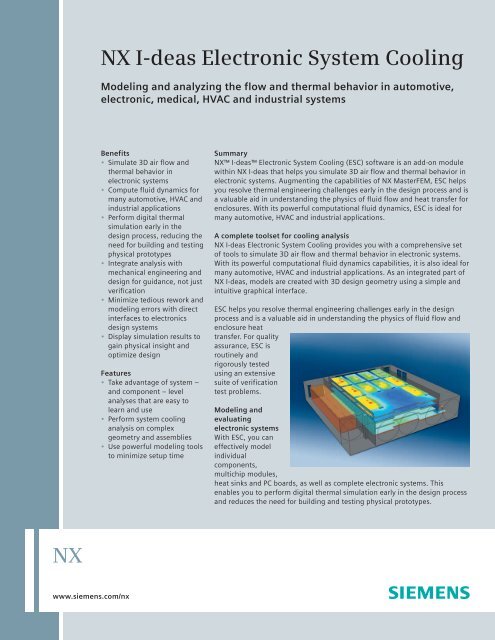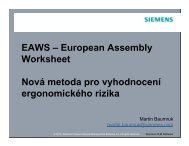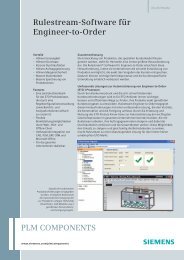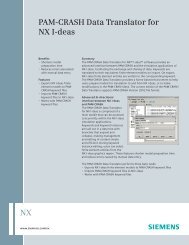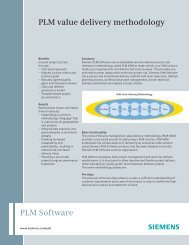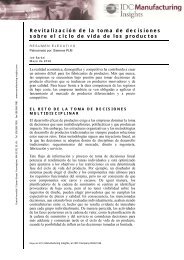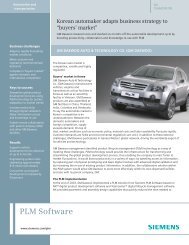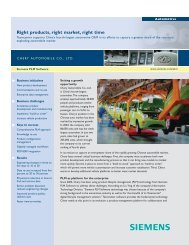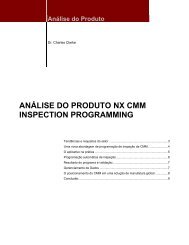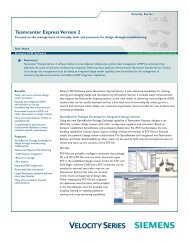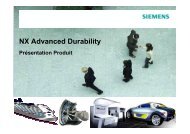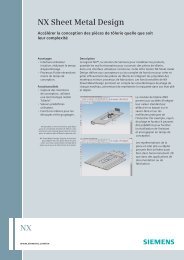NX I-DEAS Electronic System Cooling - Siemens PLM Software
NX I-DEAS Electronic System Cooling - Siemens PLM Software
NX I-DEAS Electronic System Cooling - Siemens PLM Software
You also want an ePaper? Increase the reach of your titles
YUMPU automatically turns print PDFs into web optimized ePapers that Google loves.
<strong>NX</strong> I-deas <strong>Electronic</strong> <strong>System</strong> <strong>Cooling</strong><br />
Modeling and analyzing the flow and thermal behavior in automotive,<br />
electronic, medical, HVAC and industrial systems<br />
Benefits<br />
• Simulate 3D air flow and<br />
thermal behavior in<br />
electronic systems<br />
• Compute fluid dynamics for<br />
many automotive, HVAC and<br />
industrial applications<br />
• Perform digital thermal<br />
simulation early in the<br />
design process, reducing the<br />
need for building and testing<br />
physical prototypes<br />
• Integrate analysis with<br />
mechanical engineering and<br />
design for guidance, not just<br />
verification<br />
• Minimize tedious rework and<br />
modeling errors with direct<br />
interfaces to electronics<br />
design systems<br />
• Display simulation results to<br />
gain physical insight and<br />
optimize design<br />
Features<br />
• Take advantage of system –<br />
and component – level<br />
analyses that are easy to<br />
learn and use<br />
• Perform system cooling<br />
analysis on complex<br />
geometry and assemblies<br />
• Use powerful modeling tools<br />
to minimize setup time<br />
Summary<br />
<strong>NX</strong> I-deas <strong>Electronic</strong> <strong>System</strong> <strong>Cooling</strong> (ESC) software is an add-on module<br />
within <strong>NX</strong> I-deas that helps you simulate 3D air flow and thermal behavior in<br />
electronic systems. Augmenting the capabilities of <strong>NX</strong> MasterFEM, ESC helps<br />
you resolve thermal engineering challenges early in the design process and is<br />
a valuable aid in understanding the physics of fluid flow and heat transfer for<br />
enclosures. With its powerful computational fluid dynamics, ESC is ideal for<br />
many automotive, HVAC and industrial applications.<br />
A complete toolset for cooling analysis<br />
<strong>NX</strong> I-deas <strong>Electronic</strong> <strong>System</strong> <strong>Cooling</strong> provides you with a comprehensive set<br />
of tools to simulate 3D air flow and thermal behavior in electronic systems.<br />
With its powerful computational fluid dynamics capabilities, it is also ideal for<br />
many automotive, HVAC and industrial applications. As an integrated part of<br />
<strong>NX</strong> I-deas, models are created with 3D design geometry using a simple and<br />
intuitive graphical interface.<br />
ESC helps you resolve thermal engineering challenges early in the design<br />
process and is a valuable aid in understanding the physics of fluid flow and<br />
enclosure heat<br />
transfer. For quality<br />
assurance, ESC is<br />
routinely and<br />
rigorously tested<br />
using an extensive<br />
suite of verification<br />
test problems.<br />
Modeling and<br />
evaluating<br />
electronic systems<br />
With ESC, you can<br />
effectively model<br />
individual<br />
components,<br />
multichip modules,<br />
heat sinks and PC boards, as well as complete electronic systems. This<br />
enables you to perform digital thermal simulation early in the design process<br />
and reduces the need for building and testing physical prototypes.<br />
<strong>NX</strong><br />
www.siemens.com/nx
<strong>NX</strong><br />
<strong>NX</strong> I-deas <strong>Electronic</strong> <strong>System</strong> <strong>Cooling</strong><br />
Features continued<br />
• Employ a wide range of<br />
simulation capabilities<br />
• Gain rapid and reliable<br />
results employing advanced<br />
thermal and CFD solver<br />
technology<br />
Applications<br />
ESC is capable of modeling<br />
more than simple electronic<br />
enclosures. It can be applied<br />
to a broad range of industries<br />
and products:<br />
Computers and peripherals<br />
• Individual components such<br />
as disk drives, large rack<br />
mounted systems and<br />
printers<br />
Consumer electronics<br />
• Ideally suited to complex<br />
geometry and compact<br />
packaging challenges<br />
Medical and instrumentation<br />
• <strong>Electronic</strong> systems and<br />
instrument sensors and<br />
control systems<br />
Automotive electronics<br />
• Individual electronic modules<br />
and electrical systems<br />
exposed to extreme<br />
environments<br />
Automotive cooling<br />
and heating<br />
• Heating and ventilation<br />
systems, underhood and car<br />
cooling, as well as<br />
headlamps<br />
Communication<br />
• Rack-mounted systems in<br />
climate-controlled rooms and<br />
outdoor equipment in<br />
extreme environments<br />
Aerospace and avionics<br />
• Electrical and electronic<br />
systems on aircraft as well as<br />
lighting systems<br />
Building HVAC/clean room<br />
ventilation<br />
• Duct systems, ventilation<br />
diffusers and investigating<br />
flow in large spaces or<br />
controlled environments<br />
Unstructured free meshing and powerful<br />
mesh coupling technology enable you to<br />
use a single model for both system-level<br />
and component-level analyses. ESC helps<br />
you quickly perform a detailed thermal<br />
analysis and pinpoint design problems.<br />
ESC assists with practical thermal<br />
engineering challenges, such as optimizing<br />
critical component placement or predicting<br />
the operating point from the manufacturer’s<br />
fan curve data. You can investigate<br />
both forced and natural convection cooling<br />
schemes, and evaluate the positioning and<br />
sizing of fans and vents.<br />
ESC automatically aids with spacing<br />
requirements between boards and<br />
assemblies. It also helps optimize the size<br />
and shape of heat sinks to maximize<br />
convection. In addition, you can investigate<br />
conductive heat transfer using<br />
thermal vias, heat pipes and heat<br />
spreaders.<br />
Mechanical design integration<br />
Integration with <strong>NX</strong> I-deas digital product<br />
design suite enables you to effectively use<br />
simulation to provide design guidance, not<br />
just verification. As an integral part of ESC,<br />
no additional input files or geometry<br />
conversions are needed to build thermal<br />
and flow models.<br />
ESC responds to the needs of mechanical<br />
design specialists and nonspecialists alike,<br />
providing rapid turnaround. Integrity is<br />
assured by maintaining data associativity<br />
between model building, solving and<br />
results interpretation. ESC provides the<br />
ability to model, catalog and share parts<br />
and material libraries among the entire<br />
design team.<br />
Minimizing tedious rework and modeling<br />
errors, ESC interfaces with EDA design<br />
systems for direct data exchange with PCB<br />
layout programs using PCB.xchange. ESC is<br />
fully coupled to TMG Thermal Analysis<br />
within <strong>NX</strong> I-deas, offering both advanced<br />
conduction and advanced radiation<br />
modeling. Flow and thermal results can be<br />
used as boundary conditions for thermal<br />
stress and deflection analysis with <strong>NX</strong><br />
Model Solution, also within <strong>NX</strong> I-deas.<br />
Easy to learn<br />
and use<br />
ESC uses a simple<br />
and intuitive<br />
interface. All<br />
functions are<br />
performed using<br />
icons and forms.<br />
Modeling is<br />
performed directly<br />
on design<br />
geometry. ESC uses<br />
terminology familiar to electronics<br />
packaging engineers and offers intelligent<br />
defaults for all options. Input is verified as<br />
it is entered on the form, and modeling<br />
units are shown.<br />
Model checks and diagnostics alert you to<br />
modeling mistakes and provide quick<br />
solution summaries to help verify your<br />
results. Online help and reference<br />
materials are always available to guide you<br />
through all modeling operations. ESC<br />
provides simple and reliable tools to meet<br />
the most demanding analysis<br />
requirements.<br />
Modeling complex geometry<br />
ESC provides an extensive set of tools for<br />
creating analysis geometry. The modeling<br />
of complex assemblies is made easy with<br />
<strong>NX</strong> MasterFEM within <strong>NX</strong> I-deas.<br />
Automated free meshing tools enable you<br />
to quickly model parts using precise<br />
wireframe, surface and solid geometry.<br />
You can refine the mesh in critical areas<br />
and selectively control mesh density,<br />
minimizing model size for rapid solution<br />
times. Full associativity with design<br />
geometry means that the mesh is<br />
automatically updated when your design<br />
is modified.
<strong>NX</strong><br />
Applications continued<br />
Component and electronic<br />
packages<br />
• Detailed modeling of wirebonded,<br />
flipchip, MCM and<br />
BGA packages (This can be<br />
used in combination with <strong>NX</strong><br />
Model Solution Nonlinear<br />
within <strong>NX</strong> I-deas to solve<br />
thermal stress and distortion<br />
problems)<br />
Biomedical<br />
• Blood flow, viscoplastic fluids<br />
flow, medical fluid exchange<br />
and circulation systems<br />
<strong>System</strong> requirements<br />
<strong>Electronic</strong> <strong>System</strong> <strong>Cooling</strong><br />
shares the <strong>NX</strong> I-deas system<br />
requirements.<br />
Recommended system<br />
configuration<br />
For information on particular<br />
operating systems or<br />
graphics cards, please visit<br />
http://support.ugs.com/<br />
Unique modeling approach<br />
Analysis turnaround is significantly<br />
reduced through the use of powerful<br />
modeling tools. The fluid flow mesh does<br />
not need to be aligned to the solid thermal<br />
mesh. The fluid flow model adapts around<br />
convecting surfaces and flow obstructions.<br />
Convection heat transfer from the<br />
components, boards and enclosures is<br />
calculated using local flow conditions and<br />
geometry. The simulation can be tuned for<br />
modeling convection from PC boards and<br />
the drag due to components. Heat transfer<br />
coefficients and surface roughness can be<br />
automatically calculated or specified.<br />
Dissimilar meshes are automatically<br />
coupled, greatly simplifying meshing and<br />
dramatically reducing mesh density.<br />
Thermal couplings are automatically<br />
established based on proximity and are<br />
distributed to account for overlap or<br />
mismatch between dissimilar meshes.<br />
This is a powerful tool for modeling<br />
junction-to-case thermal resistances,<br />
component-to-PCB interfaces, card edge<br />
guides, bolted or bonded connections,<br />
multilayer materials and free convection<br />
from exterior surfaces. Isotropic and<br />
orthotropic conduction can be modeled<br />
using 3D solid, 2D shell and beam<br />
elements.<br />
Powerful computational fluid dynamics<br />
and thermal simulation<br />
ESC uses computational fluid dynamics<br />
coupled with a finite volume thermal<br />
solver to accurately and efficiently<br />
simulate fluid flow, convection, conduction<br />
and radiation. An element-based, finite<br />
volume CFD scheme is used to compute 3D<br />
fluid velocity, temperature and pressure by<br />
solving the Navier-Stokes equations.<br />
The combination of 3D CFD and thermal<br />
solver technology allows you to simulate<br />
complex situations, including:<br />
• Coupled 3D fluid flow and thermal<br />
problems<br />
• Component heat loads and operating<br />
temperatures<br />
• Forced, natural and mixed convection<br />
on arbitrary geometry<br />
• Turbulent, laminar and mixed flows<br />
• Steady-state and transient analysis<br />
• Multiple enclosures<br />
• Internal or external flows<br />
• Orthotropic and isotropic conduction<br />
• Nonlinear material properties<br />
• Radiative heat transfer between surfaces<br />
• Thermal characterization of component<br />
packages and heat sinks<br />
• Internal and external fans<br />
• Predicting the fan operating point with<br />
manufacturing fan-curve data<br />
• Recirculation systems<br />
• Altitude effects<br />
• Losses in fluid flow due to screens, filters<br />
and other obstructions<br />
• Convection to the surrounding<br />
environment and solar heat loads<br />
• Moving or rotating surfaces<br />
• Slip and symmetry conditions<br />
• Thermoelectric coolers<br />
• Rotating machinery, including<br />
periodicity<br />
• Humidity, condensation and evaporation<br />
• Particle tracking<br />
• Non-newtonian fluid flow<br />
- Power Law (molten polymers)<br />
- Herschel-Bulkley and Bigham for<br />
viscoplastic fluids (blood flow, drilling<br />
mud, nuclear fuel slurry, etc.)<br />
• Supersonic flow up to Mach 4<br />
Robust and reliable solver technology<br />
ESC combines the versatility of FEM-based<br />
analysis with the power and accuracy of<br />
a control-volume formulation. The fluid<br />
flow and thermal models are solved<br />
iteratively. Algebraic, multigrid solver<br />
technology is used to ensure efficient<br />
solution convergence; solution time is<br />
linear with model size.<br />
Calculation points for momentum, mass<br />
and energy are co-located and the<br />
momentum and mass equations are solved<br />
together. Turbulence models include<br />
mixing length, k-e and fixed turbulent<br />
viscosity. Advanced 3-layer log-law wall<br />
functions are used to model convection<br />
and surface effects. First- or second-order<br />
advection schemes can be selected.<br />
During analysis execution, a solver monitor<br />
dynamically plots solution convergence<br />
and displays intermediate results to<br />
monitor progress. You can stop the<br />
solution, display intermediate results or<br />
change solution parameters and restart<br />
at any time.
<strong>NX</strong><br />
Simulation results<br />
Simulation results can be displayed with<br />
graphical plots, charts and reports. This<br />
helps you understand and gain physical<br />
insight, as well as improve or optimize<br />
your design. Results can be displayed using<br />
3D vector, particle path, contour, criterion<br />
and carpet plots. You can dynamically<br />
rotate result displays and interactively<br />
probe for specific data. It is easy to<br />
generate tabular reports, XY or XYZ<br />
graphs to communicate your results to a<br />
design team.<br />
The following simulation results are<br />
available for post-processing:<br />
• Fluid velocity<br />
• Fluid and solid temperatures<br />
• Fan, vent and screen mass flux<br />
• Heat flux<br />
• Fluid pressure<br />
• Heat transfer coefficients<br />
• K-∈ turbulence data<br />
• Fluid density<br />
• Surface shear stresses<br />
• Error and local dimensionless values<br />
• Mach number<br />
• HVAC human thermal comfort results:<br />
- ASHRAE Predicted Mean Vote (PMV)<br />
- ASHRAE Predicted Percent<br />
Dissatisfied (PPD)<br />
Contact<br />
<strong>Siemens</strong> <strong>PLM</strong> <strong>Software</strong><br />
Americas 800 498 5351<br />
Europe 44 (0) 1276 702000<br />
Asia-Pacific 852 2230 3333<br />
www.siemens.com/nx<br />
© 2011 <strong>Siemens</strong> Product Lifecycle Management <strong>Software</strong><br />
Inc. All rights reserved. <strong>Siemens</strong> and the <strong>Siemens</strong> logo are<br />
registered trademarks of <strong>Siemens</strong> AG. D-Cubed, Femap,<br />
Geolus, GO <strong>PLM</strong>, I-deas, Insight, JT, <strong>NX</strong>, Parasolid, Solid<br />
Edge, Teamcenter, Tecnomatix and Velocity Series are<br />
trademarks or registered trademarks of <strong>Siemens</strong> Product<br />
Lifecycle Management <strong>Software</strong> Inc. or its subsidiaries in<br />
the United States and in other countries. All other logos,<br />
trademarks, registered trademarks or service marks used<br />
herein are the property of their respective holders.<br />
X3 2568 2/11 B


